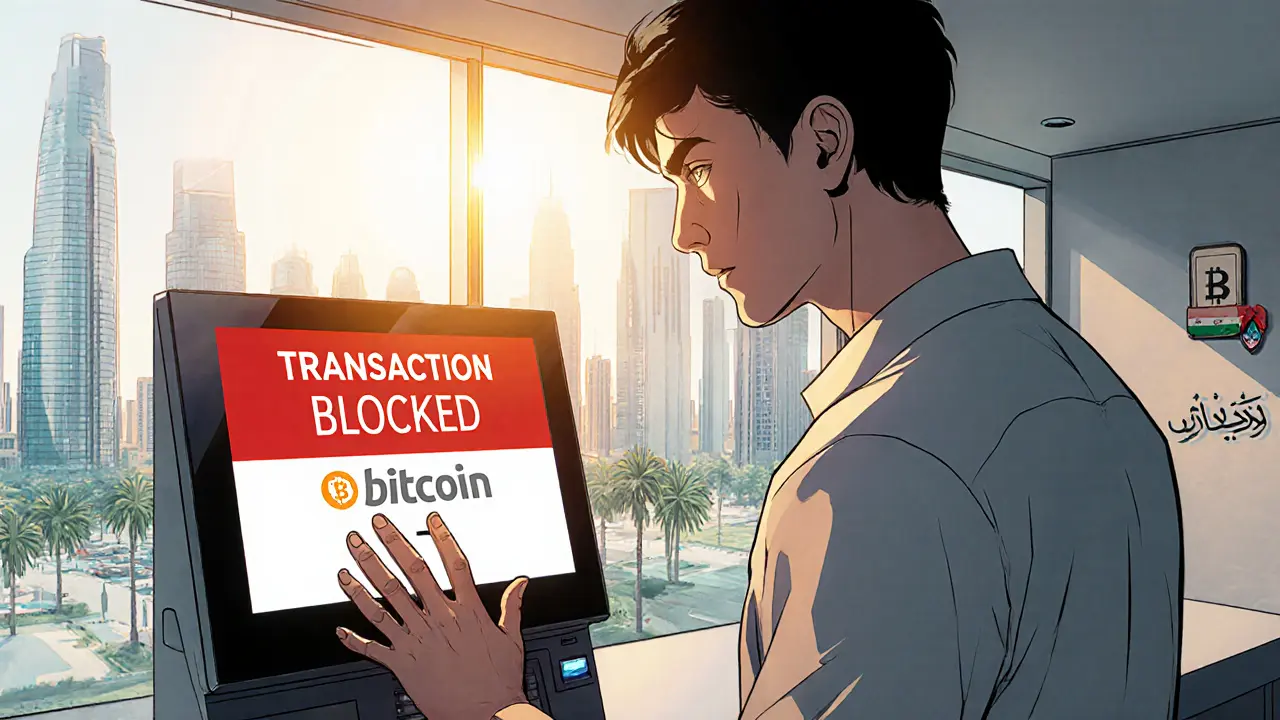Understanding Saudi Arabia's Banking Ban on Crypto Transactions

Saudi Crypto Market Projection Calculator
Market Size Calculator
Based on Saudi Arabia's 2024 crypto market size of $23.1 billion and projected growth rate of 7.9% CAGR, calculate potential market value through 2033.
Projected Market Size in 2033
Based on your inputs, Saudi Arabia's crypto market is projected to reach $ billion by 2033.
This aligns with the article's projection of $45.9 billion at 7.9% CAGR.
Imagine trying to buy Bitcoin, but your bank instantly blocks the transaction. That’s the everyday reality for many in Saudi Arabia, where a strict banking ban on crypto transactions hangs over the booming digital‑asset market.
What the banking ban actually means
Saudi Arabia crypto ban is a regulatory policy that bars all Saudi financial institutions from facilitating any cryptocurrency‑related activity unless they receive explicit permission from the Saudi Arabian Monetary Authority (SAMA). Launched in 2018, the ban was reinforced by a series of warnings from the Standing Committee for Awareness on Dealing in Securities Activities and a 2019 Ministry of Finance advisory that labeled virtual currencies as “neither legally recognized nor regulated.”
In practice, the rule creates a hard wall between traditional banking services-such as account transfers, deposits, or fiat‑to‑crypto conversions-and the digital‑asset ecosystem. Banks that ignore the restriction risk punitive actions, while those that seek approval must navigate a slow, opaque vetting process.
How individuals are coping
- Most Saudis who own crypto do so through overseas exchanges that accept international cards or peer‑to‑peer (P2P) platforms.
- When they need to cash out, they often rely on friends abroad, informal money‑transfer networks, or crypto‑to‑fiat gateways that bypass local banks.
- The lack of a regulated on‑ramp pushes many to hold assets in wallets for the long term, limiting liquidity and increasing price‑risk exposure.
Despite these hurdles, a 2024 survey found that roughly 11.4% of the Saudi population-about four million people-still own crypto assets, showing that personal adoption persists even when banks say “no.”
Impact on crypto businesses and exchanges
Without access to Saudi banking, local exchanges must engineer alternative payment flows. Common strategies include:
- Partnering with foreign banks that can receive Saudi Riyal deposits via correspondent accounts.
- Using stablecoin gateways that convert Riyals to a stable digital token, which can then be swapped for Bitcoin or other assets.
- Building P2P escrow services that match sellers with buyers willing to transfer funds through non‑bank channels.
These workarounds raise compliance costs, create exposure to AML/CFT scrutiny, and complicate tax reporting. Businesses also face uncertainty because the ban applies uniformly, leaving little room for pilot projects or limited‑scope testing.
Crypto market growth despite the ban
The market in Saudi Arabia is anything but stagnant. According to a 2024 industry report:
- The total crypto‑asset market size reached $23.1billion, projected to climb to $45.9billion by 2033 at a 7.9% CAGR.
- Transaction volume exploded by 153% from July2023 to June2024, topping $31billion.
- Revenue forecasts for 2025 sit at $498.2million, with an estimated 7.4million active users.
These numbers underline a paradox: a strict banking ban coexists with a rapidly expanding crypto ecosystem, driven largely by institutional investors who have found creative ways to fund their trades.

Saudi’s paradoxical embrace of blockchain and CBDCs
While the banking sector stays frozen, the Kingdom is actively experimenting with blockchain technology. In 2024, Saudi Arabia joined the mBridge Central Bank Digital Currency (CBDC) pilot alongside the UAE, China, Thailand, and Hong Kong. The pilot, overseen by SAMA, explores cross‑border payments using a shared CBDC platform.
This dual approach shows that Saudi authorities see value in regulated digital currencies-provided they remain under tight sovereign control. The sandbox environment allows SAMA to test interoperability, settlement speed, and AML safeguards without opening the floodgates for unregulated crypto trading.
Legal, religious, and tax dimensions
Beyond banking, several other frameworks shape the crypto landscape:
- SAMA (Saudi Arabian Monetary Authority) enforces the banking ban and issues AML/CFT guidance that implicitly covers digital assets.
- Capital Market Authority (CMA) treats crypto trading as unregulated, issuing periodic warnings about speculative risk.
- A high‑ranking religious scholar issued a fatwa declaring Bitcoin and similar cryptocurrencies compliant with Sharia law, creating a religious endorsement that clashes with institutional restrictions.
- Tax treatment differentiates between individuals (no capital‑gains tax) and businesses (15% capital‑gains tax, 20% corporate tax, plus 2.5% zakat), adding another operational layer for firms without banking access.
The AML law of 2017 and the CFT law of the same year define “funds” broadly enough to capture crypto assets, meaning illicit‑use investigations can still involve digital tokens even though there is no dedicated crypto legislation.
How Saudi Arabia stacks up against its neighbours
| Country | Banking access to crypto | Official crypto framework | CBDC involvement | Religious stance |
|---|---|---|---|---|
| Saudi Arabia | Prohibited unless SAMA approval | No specific law; AML/CFT applies | Participant in mBridge pilot | Fatwa declares Sharia‑compliant |
| UAE | Allowed under regulated crypto licences | Comprehensive crypto licensing regime | Exploring own CBDC (UAE‑Dirham) | Generally supportive; no formal fatwa needed |
| Bahrain | Permitted with licence from CBB | Established regulatory sandbox | Testing CBDC prototypes | Neutral; no major religious rulings |
The table highlights how Saudi Arabia’s policy is among the most restrictive in the Gulf, even as its market size rivals that of its more permissive neighbours.

Looking ahead: possible policy shifts
Several forces could nudge the ban towards relaxation:
- Continued market growth-projected $45.9billion by 2033-creates pressure from entrepreneurs and investors seeking a clearer legal pathway.
- Vision2030’s digital‑economy goals encourage innovation, which may eventually require a formal crypto framework.
- International cooperation on CBDCs could standardise AML/CFT practices, giving regulators confidence to open limited banking channels.
- The fatwa’s religious approval may influence legislators to consider a more balanced stance that aligns financial stability with Sharia compliance.
Still, SAMA’s risk‑averse culture suggests any change will be incremental, likely beginning with pilot licences for custodial services rather than a full banking overhaul.
Quick takeaways
- The banking ban forbids Saudi banks from handling crypto without SAMA clearance.
- Individuals circumvent the ban via overseas exchanges and P2P networks.
- Crypto businesses resort to foreign banking partners, stablecoin gateways, and complex compliance setups.
- Despite restrictions, the market surged to $23.1billion in 2024 and keeps growing.
- Saudi’s simultaneous investment in CBDC pilots signals a nuanced, future‑oriented approach.
Frequently Asked Questions
Can I legally own Bitcoin in Saudi Arabia?
Yes. Personal ownership of crypto assets is not illegal, but you cannot use a Saudi bank to buy, sell, or transfer them.
What happens if a Saudi bank processes a crypto transaction without approval?
The bank could face regulatory sanctions from SAMA, ranging from fines to revocation of its license.
Are crypto exchanges taxed in Saudi Arabia?
Businesses are subject to a 15% capital‑gains tax, 20% corporate income tax, and a 2.5% zakat levy. Individuals currently pay no capital‑gains tax.
How does the CBDC pilot affect the crypto ban?
The pilot shows SAMA’s willingness to explore regulated digital currencies, but it does not relax the existing prohibition on private crypto transactions.
Is there any chance the banking ban will be lifted soon?
Experts expect only a gradual easing, possibly starting with licensed custodial services, rather than an outright lift in the near term.
Tayla Williams
October 3, 2025 AT 19:46The prohibition raises profound ethical concerns about personal liberty. When a sovereign instructs banks to act as gatekeepers, it effectively curtails the individual's right to manage their own wealth. Moreover, the ban creates a two‑tiered financial system where only those with privileged access can navigate around the rule. This disparity entrenches inequality and runs counter to the spirit of fairness that any just society should uphold. While regulators cite consumer protection, the evidence shows that illicit activity thrives in opaque channels. By driving crypto transactions into unregulated peripheries, the policy may inadvertently increase the very risks it seeks to mitigate. A balanced approach would involve transparent licensing rather than blunt prohibition. Until such reforms are enacted, the moral legitimacy of the ban remains highly questionable.
Jazmin Duthie
October 3, 2025 AT 23:56Oh great, because the only thing people wanted was to keep their money stuck in a vault.
Michael Grima
October 4, 2025 AT 04:06Crypto is like the wild west and Saudi banks are the sheriffs who forgot their badges. The ban sounds like a plot twist nobody asked for. People will still find a way they always do. The market’s growth proves that restriction is just a speed bump. Meanwhile the regulators sit behind paperwork and wonder why the river keeps flooding. In the end innovation laughs at bureaucracy.
Della Amalya
October 4, 2025 AT 09:40The story of Saudi Arabia’s crypto repression reads like a Shakespearean tragedy, where ambition clashes with caution.
On one hand, a visionary kingdom embraces blockchain for sovereign CBDC projects, flaunting a futuristic veneer.
On the other, the same authorities slam the doors shut on private citizens yearning to trade Bitcoin.
This dichotomy fuels a restless energy among traders who refuse to be silenced.
They become modern alchemists, turning foreign cards and peer‑to‑peer whispers into golden opportunities.
Each successful P2P swap feels like a secret handshake, a rebellion whispered in café corners.
Yet the specter of fines looms over every bank that dares glance at a crypto ledger.
The compliance teams are left decoding a maze of AML‑CFT guidelines that were never meant for digital assets.
For businesses, the cost of building foreign correspondent accounts is a financial albatross that drains capital.
Stablecoin gateways, while clever, expose users to another layer of regulatory risk that can evaporate overnight.
Nevertheless, the market numbers keep climbing, as if the ban were a mere wind against a sturdy ship’s sails.
The 2024 survey showing four million Saudis holding crypto is a testament to relentless curiosity.
It also signals that any future policy shift must reckon with a populace already versed in digital finance.
Vision 2030’s digital‑economy promises may finally compel the regulators to draft a nuanced framework rather than a blunt sword.
Until then, the paradox will persist: a kingdom building its own digital currency while its people navigate the underground currents of private crypto.
Shane Lunan
October 4, 2025 AT 11:03Yeah, the drama is real. People will always find a backdoor. Banks can try to scare them but they’re like cats-nine lives. Guess the ban just adds more flavor.
Blue Delight Consultant
October 4, 2025 AT 15:13The juridical architecture surrounding digital assets invites a deeper metaphysical inquiry. If property is defined by the ability to transfer value, then prohibiting banks from facilitating such transfers challenges the very notion of ownership. Yet SAMA contends that without explicit oversight, chaos may ensue-a claim that rests on a slippery dialectic. One must ask whether the state's custodial role is propossed when individuals possess autonomous agency over their wealth. The lack of a dedicated legislative framework creates a vacuum that is filled by ad‑hoc AML interpretations. This vacuum, while intended to protect, may paradoxically erode trust in the financial system. Ultimately, a coherent legal theory is required to reconcile sovereign authority with personal liberty.
Wayne Sternberger
October 4, 2025 AT 18:00I concur with your analysis, albeit with a few practical observations. While the philosophical discourse is valuable, the day‑to‑day reality for Saudi firms is that foreign correspondent accounts are scarce and costly. Moreover, the tax regime you mentioned imposes a dual burden that dissuades local entrepreneurship. In my view, the path forward lies in a phaseed licensing model that grants conditional custodial rights under strict audit. Such a compromise respects both the state's risk aversion and the market's appetite for innovation. The misspelling of 'propossed' earlier highlights the need for precision in policy drafting as well.
Gautam Negi
October 4, 2025 AT 23:33It is tempting to view the ban as a backward‑looking relic, yet one could argue that restraint is a strategic asset. By limiting unchecked speculation, Saudi regulators preserve macro‑economic stability-a priority that many liberal jurisdictions sacrifice on the altar of growth. The CBDC pilot, in contrast, demonstrates a controlled embrace of digital finance, suggesting a deliberate bifurcation rather than inconsistency. Critics forget that sovereign digital currencies can be engineered with built‑in compliance, something private crypto cannot guarantee. Therefore, the ban may serve as a protective buffer while the kingdom refines its own digital monetary architecture. In this light, the policy aligns with a long‑term vision of a regulated, state‑backed digital economy. It also signals to international partners that Saudi Arabia will not be a wild west for illicit flows. Consequently, the apparent paradox may in fact be a calculated balance.
Linda Campbell
October 5, 2025 AT 02:20Your defense of the ban resonates with a patriotic commitment to national security. Saudi Arabia must shield its financial system from external manipulation, and the current safeguards reflect that imperative. The measured approach you describe underscores our nation's resolve to lead responsibly in the digital age. Any premature liberalisation would betray the trust of our citizens and expose us to geopolitical risks. Therefore, the strict banking stance is not only justified but essential for preserving our sovereign integrity.
Brian Elliot
October 5, 2025 AT 07:53From an inclusive standpoint, it’s heartening to see that despite regulatory friction, the crypto community in Saudi Arabia remains vibrant. The ingenuity shown by users turning to P2P networks and overseas platforms illustrates a resilient ecosystem. While the ban presents hurdles, it also sparks innovation in building alternative on‑ramps that could benefit the broader region. The data showing a $23.1 billion market size proves that demand is robust and not fleeting. If policymakers were to engage constructively with these stakeholders, a collaborative pathway could emerge that balances safety with growth. Such dialogue would honor both the kingdom’s Vision 2030 objectives and the aspirations of its tech‑savvy populace. Ultimately, fostering a supportive environment may turn these challenges into a competitive advantage on the global stage.
Marques Validus
October 5, 2025 AT 10:40Whoa legit the crypto hustle is like a hyper‑loop of liquidity that bypasses the old banking arteries.
When we talk about decentralized finance we’re basically riffing on next‑gen tokenomics that rewire capital flows.
The Saudi market is basically a sandbox alpha‑testing protocol for cross‑border settlements.
Those P2P escrow services are the MVPs of a future where fiat‑to‑crypto bridges become API‑native.
It’s a wild ride of smart‑contract orchestration and liquidity mining on steroids.
The regulatory lag is just a latency buffer before the network syncs up.
Bottom line the ecosystem is in beta but already outperforming legacy finance in agility.
Mitch Graci
October 5, 2025 AT 16:13Wow, another brilliant policy move!!! 🙄🤦♂️ Who needs financial freedom when you have endless paperwork!!! 😂
DeAnna Greenhaw
October 5, 2025 AT 19:00It is an incontrovertible observation that the Kingdom's dichotomous stance toward digital assets epitomizes the paradox of modern governance. On one hand, the state heralds blockchain as a conduit for sovereign innovation, ushering in the mBridge CBDC pilot with the aplomb of a technocratic vanguard. On the other, it erects impermeable barriers to private crypto participation, thereby cultivating an ecosystem of clandestine transactions that operates in the penumbra of regulatory oversight. Such a bifurcated policy framework not only engenders cognitive dissonance among market participants but also precipitates a suboptimal allocation of capital, as resources are diverted toward circumventing mechanisms rather than productive investment. The empirical data, as delineated in the aforementioned report, attests to a market that flourishes despite institutional constraints, a testament to the inherent adaptability of decentralized finance. In summation, one must concede that the prevailing regulatory posture, while ostensibly protective, may inadvertently stifle the very dynamism it purports to safeguard, thereby warranting a calibrated recalibration.